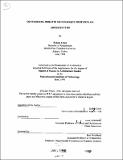| dc.contributor.advisor | Mark Jarzombek. | en_US |
| dc.contributor.author | Erten, Erdem, 1972- | en_US |
| dc.date.accessioned | 2011-09-27T18:29:23Z | |
| dc.date.available | 2011-09-27T18:29:23Z | |
| dc.date.copyright | 1998 | en_US |
| dc.date.issued | 1998 | en_US |
| dc.identifier.uri | http://hdl.handle.net/1721.1/65989 | |
| dc.description | Thesis (M.S.)--Massachusetts Institute of Technology, Dept. of Architecture, 1998. | en_US |
| dc.description | Includes bibliographical references (leaves 80-86). | en_US |
| dc.description.abstract | Horatio Greenough (1805-1852), the Bostonian sculptor, is an important intellectual of the antebellum United States. The sculptor is renowned for his two colossal pieces that were placed on the grounds of the U.S. Capitol, ''Rescue'' and "George Washington," together with his writings on architecture. Greenough's writings echo the discursive agenda of modem architecture to a surprising degree in terms of truth to material, refraining from ornament, the machine analogy, the building's adaptation to the site, the organic growth of form and the expression of the inside on the outside. Therefore texts of architectural historiography, especially written during the 1940s and 1950s when functionalism was a strong discourse, regard him as a protomodernist who influenced the course of 20th century functionalism and modem architecture. However, his sculpture is surprisingly neo-classicist for those who refer to him as a pioneer of modem architecture. This apparent contradiction brings us to the need to understand Greenough's thoughts better in the context of 19th century architectural theory and the history of functionalism as a discourse. Thus, this study aims to re-contextualize Greenough's work to understand his thoughts on architecture. His writings and his sculpture are viewed in the light of his ideological position with reference to its moral, religious, and nationalist constituents. It also questions the perception of architectural theory as a pure and detached body of knowledge, abstracted from the historical context that engendered its formulation. Such an abstraction is the main reason for aesthetic discourses to appear similar. This study also sheds light on the problematic position of the historian in terms of reconstructing history filtered through his own agenda. While it exemplifies this position by Greenough's case, it reformulates that history through a contextual reading with specific reference to architecture. | en_US |
| dc.description.statementofresponsibility | by Erdem Erten. | en_US |
| dc.format.extent | 86 leaves | en_US |
| dc.language.iso | eng | en_US |
| dc.publisher | Massachusetts Institute of Technology | en_US |
| dc.rights | M.I.T. theses are protected by
copyright. They may be viewed from this source for any purpose, but
reproduction or distribution in any format is prohibited without written
permission. See provided URL for inquiries about permission. | en_US |
| dc.rights.uri | http://dspace.mit.edu/handle/1721.1/7582 | en_US |
| dc.subject | Architecture | en_US |
| dc.subject | Greenough, Horatio, 1805-1852 | en_US |
| dc.title | Questioning Horatio Greenough's thought on architecture | en_US |
| dc.type | Thesis | en_US |
| dc.description.degree | M.S. | en_US |
| dc.contributor.department | Massachusetts Institute of Technology. Department of Architecture | |
| dc.identifier.oclc | 40154559 | en_US |
